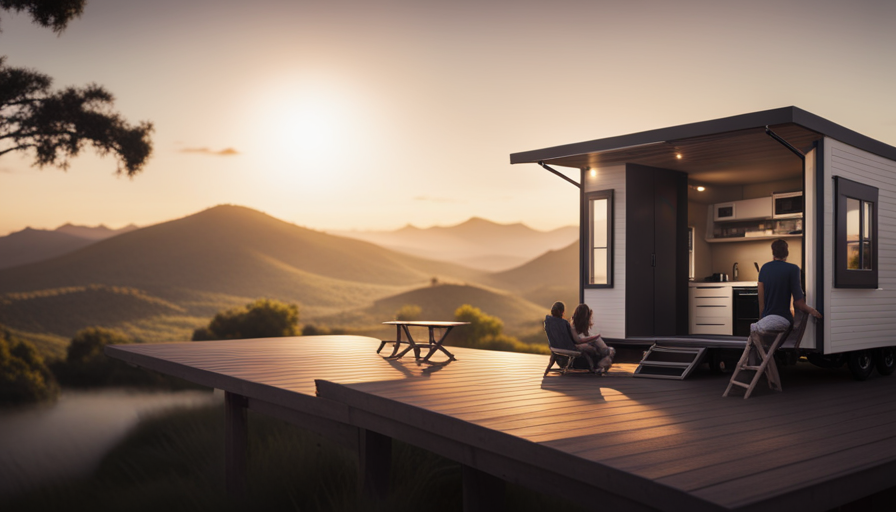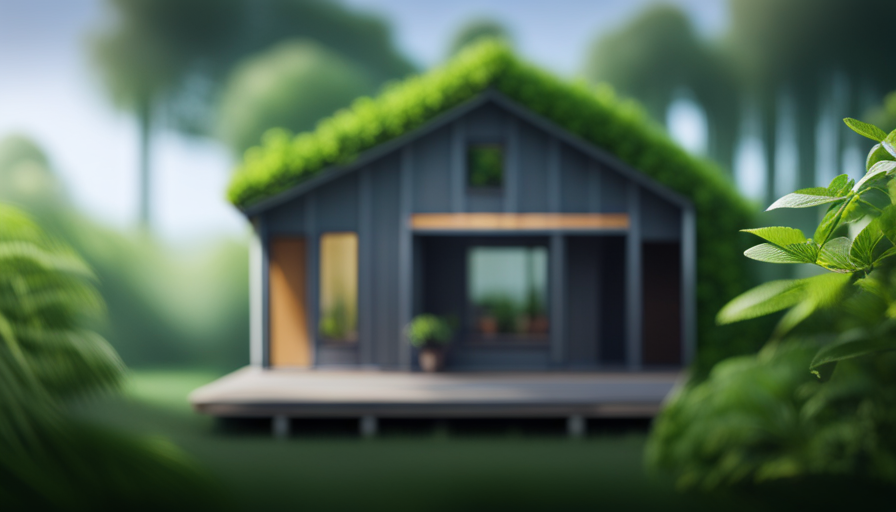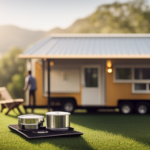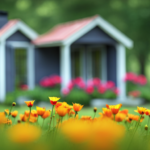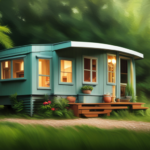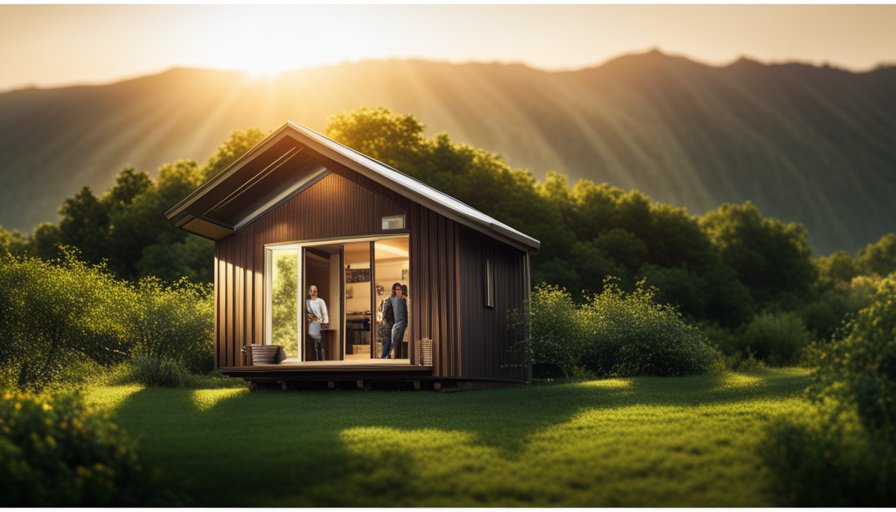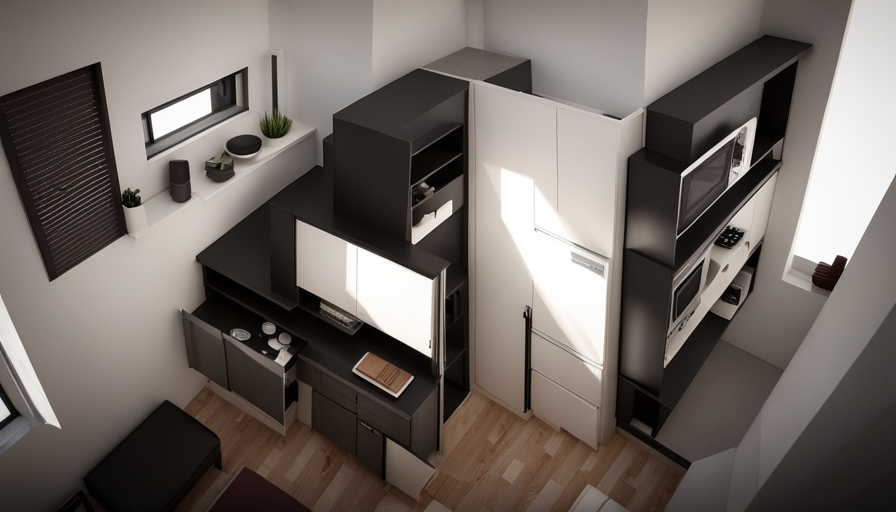Have you ever wondered how big you can make a tiny house on wheels? Well, wonder no more! Let’s dive into the legal guidelines, transportation restrictions, design elements, financial implications, eco-friendly aspects, accessibility features, and how living in a tiny house on wheels can change your lifestyle for the better. Find out all you need to know about building a tiny house on wheels right here!
Legal regulations and building codes play a crucial role in determining the size limitations of a tiny house on wheels. These regulations ensure safety and compliance with local laws. Additionally, transportation limitations must be taken into account when designing a tiny house on wheels, as it needs to be road-worthy and easily towable.
Practical living considerations such as space optimization, storage solutions, and multi-purpose furniture are essential in maximizing the functionality of a tiny house on wheels. Budget and cost considerations are also important factors to consider, as building a tiny house on wheels can vary significantly in terms of expenses.
Furthermore, environmental sustainability is a growing concern for many individuals, and building a tiny house on wheels allows for a more eco-friendly lifestyle. Accessibility and universal design ensure that the tiny house is suitable for people of all abilities.
Lastly, lifestyle and future plans should be considered when designing a tiny house on wheels, as it provides flexibility and mobility for those who seek a nomadic lifestyle. So, let’s dive into the world of tiny houses on wheels and discover the endless possibilities that await!
Key Takeaways
- Legal regulations and zoning restrictions dictate the size of tiny houses on wheels.
- Transportation limitations include weight restrictions and road capacity.
- Practical living considerations involve determining living space, maximizing storage, and designing for comfort and functionality.
- Budget and cost considerations should be carefully planned and can be reduced through strategies like using reclaimed materials and prioritizing energy efficiency.
Legal Regulations and Building Codes
You won’t believe the frustrating restrictions and red tape that limit the size of tiny houses on wheels due to legal regulations and building codes.
When it comes to tiny houses on wheels, there are various legal implications and zoning restrictions that dictate their size. Many jurisdictions have specific rules regarding the maximum square footage and height of these portable dwellings. For example, some areas may limit the size of a tiny house on wheels to 400 square feet or less. These regulations aim to ensure safety, prevent overcrowding, and maintain the character of neighborhoods. However, these limitations can be quite restrictive for those looking to build a larger tiny house on wheels.
As we delve further into the topic, we’ll also explore the transportation limitations that come into play.
Transportation Limitations
Despite being on wheels, the size of a tiny house can still be restricted due to transportation limitations, as the road becomes a narrow path for dreams. When it comes to transporting a tiny house, there are certain restrictions that need to be considered.
One of the main limitations is weight. Different states have different weight limits for vehicles traveling on their roads, and exceeding these limits can result in fines or even the impoundment of the tiny house. Additionally, certain roads may have weight restrictions, especially if they’re not built to handle heavy loads.
It’s important to carefully plan the design and construction of a tiny house on wheels to ensure it meets transportation restrictions and weight limits. Considering these transportation limitations is crucial for a smooth and hassle-free journey with your tiny house on wheels.
Moving on to practical living considerations, it’s important to plan the interior layout and amenities to maximize the functionality and comfort of the space.
Practical Living Considerations
When it comes to practical living considerations in a tiny house, there are three key points that should be taken into account.
Firstly, determining the desired living space and amenities is crucial in order to make the most of the limited square footage.
Secondly, maximizing storage and organization solutions is essential for keeping the space clutter-free and functional.
Lastly, designing for comfort and functionality ensures that every inch of the tiny house is optimized to create a cozy and livable environment.
By considering these factors, one can create a tiny house that’s not only efficient but also comfortable to live in.
Determining the desired living space and amenities
While considering the desired living space and amenities, it’s crucial to determine the size of the tiny house on wheels. The living space design should be carefully planned to optimize every square inch. Here are some factors to consider:
-
Layout: Plan the layout to maximize functionality and create separate areas for sleeping, eating, and living. Utilize multi-purpose furniture to save space.
-
Storage: Incorporate clever storage solutions like built-in cabinets, loft beds with storage underneath, and wall-mounted shelves. Every nook and cranny should be utilized efficiently.
-
Amenities: Choose amenities that are essential for your lifestyle, such as a compact kitchen with necessary appliances, a bathroom with a space-saving composting toilet, and a comfortable seating area.
By carefully considering the living space design and amenities selection, you can create a tiny house that meets your needs and preferences. Maximizing storage and organization solutions is the next important step to ensure a clutter-free and functional living space.
Maximizing storage and organization solutions
To truly optimize your living experience, you’ll want to prioritize maximizing storage and organization solutions in your tiny abode. When every square inch counts, it’s essential to get creative with space-saving ideas. Here are some innovative ways to maximize storage in your tiny house:
| Vertical Space | Multi-purpose Furniture | Hidden Storage |
|---|---|---|
| Utilize vertical space with tall shelves or hanging organizers. | Invest in furniture that serves multiple functions, such as a sofa that doubles as a storage unit or a bed with built-in drawers. | Make use of hidden storage options like under-bed storage, fold-away tables, or built-in wall cabinets. |
By incorporating these ideas into your tiny house design, you can make the most of the limited space available. Now, let’s explore how to design for comfort and functionality without compromising on style.
Designing for comfort and functionality
In order to create a cozy and efficient living space, you need to consider the design elements that will make your small sanctuary feel like a luxurious getaway. When it comes to interior design in a tiny house on wheels, space optimization is key.
Every square inch counts, so it’s important to utilize clever storage solutions and multifunctional furniture. Built-in shelves and cabinets can maximize vertical space, while foldable tables and convertible beds can provide flexibility and functionality. Additionally, choosing light colors for walls and furniture can create an illusion of a larger space. Incorporating large windows and skylights can bring in natural light and make the interior feel more open.
By carefully planning the layout and incorporating smart design choices, you can make your tiny house on wheels both comfortable and functional.
Moving on to budget and cost considerations, it’s important to carefully plan your expenses and prioritize your needs.
Budget and Cost Considerations
When it comes to budget and cost considerations, you’ll want to think about how much you’re willing to invest in your tiny house on wheels. Budget constraints can play a significant role in determining the size and features of your tiny home.
To help you navigate the financial aspect of building a tiny house, here are five cost-saving strategies to consider:
- Opt for a smaller footprint: The smaller the house, the less it will cost to build.
- Use reclaimed materials: Salvaging materials can significantly reduce costs while adding character to your tiny house.
- DIY as much as possible: Taking on some of the construction work yourself can save you money on labor costs.
- Prioritize energy efficiency: Investing in energy-efficient appliances and insulation can lower your long-term utility bills.
- Plan for minimal maintenance: Choose durable materials and low-maintenance features to save on future repairs.
Considering these budget-friendly options, you can create a comfortable and functional tiny house that meets your needs without breaking the bank.
As we move into the next section about environmental sustainability, it’s important to consider the long-term benefits of these cost-saving strategies.
Environmental Sustainability
When it comes to building a tiny house on wheels, it’s important to consider environmental sustainability. This means choosing eco-friendly materials and systems that minimize the impact on the environment.
Additionally, incorporating renewable energy sources such as solar panels can help to reduce the reliance on non-renewable resources.
Finally, minimizing environmental impact and waste by using efficient insulation and water-saving fixtures can make a significant difference in the overall sustainability of a tiny house.
Choosing eco-friendly materials and systems
You can go green by using eco-friendly materials and systems in your tiny house on wheels, making it as environmentally friendly as a breath of fresh air. By choosing eco-friendly building materials such as reclaimed wood, recycled metals, and low VOC paints, you can reduce the environmental impact of your tiny house. Additionally, incorporating energy-efficient systems like LED lighting, solar panels, and energy-efficient appliances can significantly reduce your energy consumption.
To help you visualize the impact of these choices, here is a table showcasing some eco-friendly materials and systems you can consider for your tiny house on wheels:
| Eco-friendly Materials | Energy-efficient Systems | Cost-effective Choices |
|---|---|---|
| Reclaimed wood | LED lighting | Low VOC paints |
| Recycled metals | Solar panels | Energy-efficient windows |
| Low VOC paints | Energy-efficient appliances | Insulation made from recycled materials |
By incorporating these eco-friendly materials and systems, you can create a sustainable and energy-efficient living space. In the subsequent section, we will explore the benefits of incorporating renewable energy sources for your tiny house on wheels.
Incorporating renewable energy sources
If you want to create a truly sustainable and energy-efficient living space, consider incorporating renewable energy sources into your tiny home. By utilizing renewable energy technologies, you can reduce your dependence on traditional power sources and minimize your carbon footprint.
One option is to install solar panels on the roof of your tiny house. These panels capture sunlight and convert it into electricity, providing a clean and renewable source of power. Additionally, you can incorporate energy efficiency measures such as LED lighting, energy-efficient appliances, and insulation to further reduce your energy consumption.
By combining renewable energy sources with energy-efficient practices, you can create a tiny home that is not only environmentally friendly but also cost-effective.
Transitioning into the next section about minimizing environmental impact and waste, it’s important to consider other ways to reduce your ecological footprint.
Minimizing environmental impact and waste
By implementing eco-friendly practices and waste reduction strategies, your sustainable living space can have a minimal impact on the environment and contribute to a more sustainable future. Here are some ways to minimize energy consumption and reduce your carbon footprint:
- Use energy-efficient appliances and lighting to lower electricity usage.
- Install solar panels or wind turbines to generate renewable energy.
- Implement proper insulation and sealing to reduce heating and cooling needs.
- Harvest rainwater for non-potable uses like watering plants or flushing toilets.
- Compost organic waste to minimize landfill contribution and create nutrient-rich soil.
These strategies not only help in minimizing environmental impact but also save you money in the long run. By adopting these practices, you can create a tiny house that’s both eco-friendly and sustainable.
In the next section, we will explore ways to make your tiny house accessible for everyone.
Accessibility and Universal Design
When it comes to designing a tiny house, it’s important to consider the needs of individuals with disabilities. One key point to focus on is ensuring easy access and mobility within the tiny house. This can be achieved through thoughtful design choices such as wider doorways, ramps instead of stairs, and grab bars in the bathroom.
Additionally, incorporating universal design principles can benefit all users by creating a space that is accessible and user-friendly for everyone, regardless of their abilities.
Designing for individuals with disabilities
Imagine the possibilities of designing a tiny house on wheels that caters to the unique needs and challenges faced by individuals with disabilities. Inclusive design is key when creating a space that is accessible to everyone. Incorporating assistive technology into the design can greatly enhance the functionality and independence of individuals with disabilities.
For example, installing ramps or lifts can ensure easy access to different areas of the tiny house. Additionally, incorporating adjustable countertops and grab bars in the bathroom can provide added support and convenience. It is important to consider the specific needs of individuals with disabilities when designing the layout and features of the tiny house. By doing so, we can create a space that promotes inclusivity and enables individuals with disabilities to live comfortably and confidently.
Transitioning into the next section, ensuring easy access and mobility within the tiny house is essential for individuals with disabilities.
Ensuring easy access and mobility within the tiny house
To ensure that individuals with disabilities can move freely and independently throughout the space, I prioritize easy access and mobility within my thoughtfully designed tiny home. This means incorporating features that make it easy for people with disabilities to navigate and use the space. Here are a few ways I ensure easy access and mobility within my tiny house:
-
Wider doorways: I make sure that the doorways in my tiny house are wide enough to accommodate wheelchairs and walkers, allowing for easy entry and exit.
-
Open floor plan: By designing an open floor plan, I eliminate unnecessary barriers and create a spacious and accessible environment.
-
Adjustable height countertops: I install countertops that can be adjusted to different heights, making it easier for individuals with mobility issues to use the kitchen and other workspaces.
By incorporating these features and more, my tiny house provides easy access and improved mobility for individuals with disabilities.
In the next section, I will discuss how I incorporate universal design principles for all users, ensuring that everyone can enjoy the space without limitations.
Incorporating universal design principles for all users
Even the most unlikely visitors to my small abode will find it surprisingly effortless to navigate and utilize the space, thanks to the incorporation of universal design principles.
Designing for inclusivity was a top priority when I planned my tiny house on wheels. I wanted to ensure that the space could accommodate different abilities and provide a comfortable living environment for everyone. To achieve this, I included wide doorways and hallways to allow for easy wheelchair access. The layout is open and spacious, with a clear path from one area to another. I also installed grab bars in the bathroom and kitchen to assist those with mobility challenges.
By considering the needs of all users, my tiny house becomes a welcoming and accessible home for everyone.
Moving forward, I’m excited to explore the lifestyle possibilities and future plans for my tiny house on wheels.
Lifestyle and Future Plans
Living in a tiny house on wheels offers the freedom to embrace a minimalist lifestyle and plan for an exciting future. As lifestyle trends shift towards simplicity and sustainability, more people are choosing to downsize and live with less.
A tiny house allows you to prioritize experiences and relationships over material possessions. By living in a smaller space, you can reduce your ecological footprint and live a more sustainable lifestyle. Minimalist living also means less time spent on cleaning and maintenance, giving you more time to pursue your passions and enjoy life.
Additionally, living in a tiny house on wheels allows for flexibility and mobility. You can easily travel and explore different places, creating memories and experiences that will last a lifetime. Whether you dream of a life on the road or a simpler and more intentional lifestyle, a tiny house on wheels can help you achieve your goals and shape a fulfilling future.
Frequently Asked Questions
Can I legally park my tiny house on wheels in a residential neighborhood?
I researched the legal restrictions regarding parking a tiny house on wheels in a residential neighborhood. It’s important to note that regulations vary depending on the specific location. In many areas, zoning and building codes may prohibit long-term parking of tiny houses on wheels in residential neighborhoods. However, some communities have embraced the tiny house movement and have created specific zoning regulations to accommodate them. It’s essential to consult with local authorities to ensure compliance with the law.
Are there any restrictions on the size and weight of a tiny house on wheels for transportation purposes?
There are size and weight restrictions for tiny houses on wheels for transportation purposes. The exact limitations vary depending on the specific regulations of different states and countries. Generally, tiny houses on wheels must adhere to maximum height, width, and length dimensions to ensure safe and legal transportation on roads. Weight restrictions are also in place to prevent overloading and ensure the structural integrity of the house and its trailer.
How do tiny house dwellers handle waste management and sewage disposal?
How do tiny house dwellers handle waste management and sewage disposal?
Are you curious about how we deal with these essential aspects of daily living in our small homes? Well, let me enlighten you.
Many tiny house enthusiasts opt for composting toilets, which are eco-friendly and don’t require water or plumbing. This allows us to be self-sufficient and off-grid when it comes to waste management.
We carefully manage our waste and ensure it’s properly composted and disposed of in an environmentally friendly manner.
What are the hidden costs associated with owning and maintaining a tiny house on wheels?
Hidden costs associated with owning and maintaining a tiny house on wheels can arise from various factors.
For instance, regular maintenance challenges such as repairing or replacing the wheels, axles, and trailer brakes can add up over time.
Additionally, there are expenses related to insurance, parking fees, and potential towing or moving costs.
It’s important to carefully consider these hidden costs before embarking on a tiny house on wheels lifestyle to ensure financial preparedness.
Are there any grants or financial incentives available for individuals looking to build and live in a tiny house on wheels?
Grants and financing options can provide a much-needed boost for those wanting to build and live in a tiny house on wheels. These incentives not only help with the initial costs of construction, but also make ongoing maintenance more manageable. Organizations like the Tiny House Community Development Fund and government programs offer grants specifically for tiny house projects.
Additionally, financing options such as personal loans and RV loans are available to help individuals achieve their dream of a mobile tiny home.
Conclusion
In conclusion, tiny houses on wheels offer a unique and sustainable living option for those seeking a simpler lifestyle. However, there are various factors that need to be considered before embarking on this adventure.
From legal regulations and transportation limitations to practical living considerations and budget constraints, it’s important to fully understand the implications.
One interesting statistic to note is that the average size of a tiny house on wheels is around 200 square feet, which is roughly the size of a one-car garage. Just imagine living comfortably in a space that compact!
Hi, I’m Emma. I’m the Editor in Chief of Tiny House 43, a blog all about tiny houses. While tree houses are often associated with childhood, they can be the perfect adult retreat. They offer a cozy space to relax and unwind, surrounded by nature. And since they’re typically built on stilts or raised platforms, they offer stunning views that traditional homes simply can’t match. If you’re looking for a unique and romantic getaway, a tree house tiny house might just be the perfect option.
